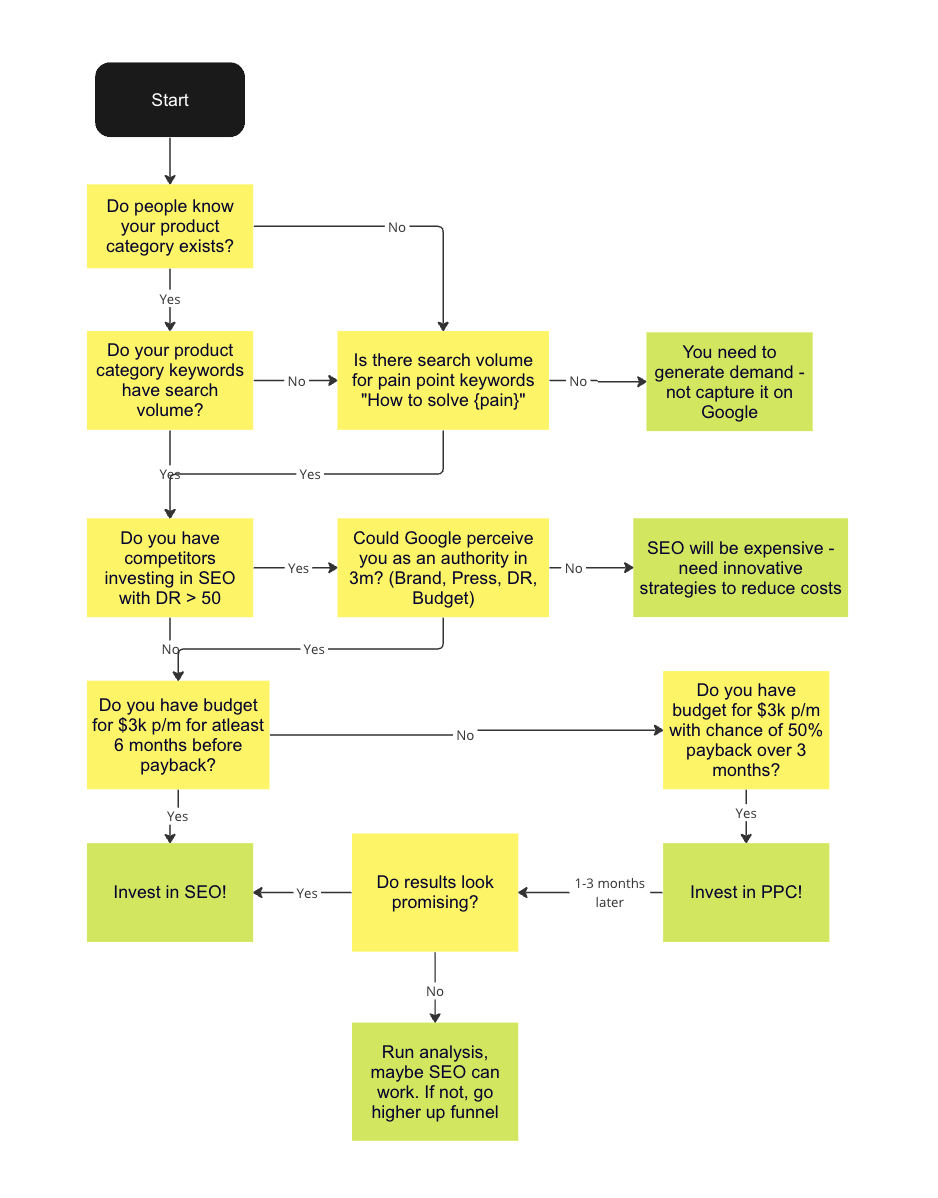Bedenken Sie dies: Ich habe mit einem B2B-SaaS-Gründer gesprochen. Er hatte bereits seine ersten Kunden über sein Netzwerk, Kaltakquise und Empfehlungen gewonnen. Und er wollte herausfinden, ob SEO der richtige Kanal ist, um in großem Umfang neue Kunden zu gewinnen.
Spoiler: Wir haben beschlossen, dass es NICHT den rechten Kanal.
Überrascht? Trotz der Verlockung großer Versprechungen von SEO-Agenturen, die bereit sind, saftige Verträge abzuschließen, sparte ihm unser Gespräch eine beträchtliche Summe - zwischen $30k und $50k an unwirksamen Marketingausgaben.
Was hat uns also zu dieser Schlussfolgerung geführt?
In diesem Artikel führe ich Sie durch unsere Diskussion und zeige Ihnen den genauen Rahmen, den wir verwendet haben, um zu bewerten, ob SEO für sein Unternehmen das Richtige ist, und gebe Ihnen auch Klarheit darüber, ob dieser Ansatz eine effektive Strategie für Ihr Unternehmen sein könnte.
Machen Sie diesen Fehler nicht
Schon zu Beginn des Gesprächs wusste ich, dass wir einen Fehlstart hingelegt hatten.
Ich habe unzählige Gespräche mit Unternehmen geführt, die in SEO investieren wollen. Wie die meisten von ihnen wollte auch dieser Gründer sofort diskutieren:
- Wie viel sollten sie ausgeben?
- Wie lange wird es dauern, bis ich "Ergebnisse" sehe?
- Wie viele Inhalte sollten sie erstellen?
- Ist ihre Domain-Autorität schon hoch genug?
Das sind Fragen, die Sie unbedingt stellen müssen, aber sie kamen viel zu früh in unserer Diskussion.
Hier ist, was ich gesagt habe:
Bevor wir uns mit diesen Fragen befassen, müssen wir ein grundlegenderes Thema diskutieren:
- Ist SEO der richtige Kanal für Ihr Unternehmen?
- Gibt es eine natürliche Passung zwischen Ihrem Produkt, dem Markt und dem SEO-Kanal (auch als "Product-Market-Channel-Fit" bezeichnet)?
- Bedeuten die Merkmale des SEO-Kanals, dass Ihr Unternehmen tatsächlich Leads von Google erhält?'
Es herrschte eine kurze Stille.
Diese Fragen sind viel schwieriger zu beantworten. Sie befassen sich mit tiefgreifenden strategischen Themen, die sowohl Geschäftssinn als auch profunde SEO-Erfahrung erfordern.
Es vergingen noch ein paar Sekunden.
Okay, und wie machen wir das jetzt?", fragte er.
Wir folgten dann dem unten stehenden Rahmen, den ich später dokumentierte und in einem Webinar vorstellte.
Der von uns befolgte Rahmen
Hier ist das Grundgerüst - und nun werde ich Sie Schritt für Schritt durch das Projekt führen.

Übrigens - ich habe ein Video aufgenommen, in dem ich diesen Rahmen durchlaufe. Spielen Sie es ab, während Sie sich den folgenden Text durchlesen:
Kategorieübernahme und Suchvolumen
Okay, zuallererst müssen Sie verstehen, dass SEO ein Kanal zur Erfassung der Nachfrage ist und NICHT eine bedarfsschaffende Maßnahme.
Das bedeutet, dass Ihre Website in den Suchergebnissen auftaucht, wenn Menschen Ihr Angebot suchen und sich dafür an eine Suchmaschine wie Google wenden.
Es funktioniert hervorragend, und Sie werden eine Vielzahl von Schlüsselwörtern für Produkte finden, für die bereits eine Nachfrage besteht, wie Unterhaltungselektronik, Haushaltsartikel oder etablierte Dienstleistungen wie Reisebuchungen oder Online-Shopping.
Aber um ehrlich zu sein, wenn Sie etwas Revolutionäres erfunden haben und dieses einzigartige Produkt online verkaufen, wird SEO nicht wirklich dazu beitragen, dass die Leute es kaufen wollen.
Es spielt wirklich keine Rolle, ob Sie "Rang #1" für eine Anfrage, wenn niemand nach ihr sucht.
Sollten Sie also Schlüsselwörter mit einem Suchvolumen von Null anvisieren?
Nun, das kommt darauf an...
Sie müssen ein wenig mit Tools wie Google Trends und Keyword Planner recherchieren und sich ein paar Fragen stellen:
- Gibt das Schlüsselwort eine klare Absicht wieder?
- Handelt es sich um ein saisonales Schlüsselwort?
- Kann dieses Schlüsselwort einen bedeutenden Mehrwert für meinen Inhalt darstellen?
- Spricht es einen Schmerzpunkt an?
Wenn alle Ihre Antworten "ja" lauten, dann könnte es sich immer noch lohnen, auf Schlüsselwörter mit einem Suchvolumen von Null zu zielen. Lautet die Antwort jedoch "Nein", dann könnte es effektiver sein, Ihre Bemühungen auf die Generierung von Nachfrage an anderer Stelle zu richten. Erfahren Sie mehr über Webflow und SEO im Vergleichund ob Webflow die richtige Wahl für Ihre SEO-Strategie ist
Wettbewerb und Behörden
Okay, der nächste Schritt besteht darin, zu wissen, mit wem man es zu tun hat.
Wenn Sie keine Konkurrenten haben, sind Sie der glücklichste Unternehmer da draußen. Aber in den meisten Fällen ist das nicht die Realität. Sie werden immer noch indirekte Konkurrenz oder Branchenriesen haben, die Ihre Präsenz überschatten könnten.
Stellen Sie sich vor, Sie sind Ihr eigener Kunde und daran interessiert, etwas zu kaufen, das Sie anbieten. Suchen Sie nun einfach nach diesem Begriff bei Google und studieren Sie die Ergebnisse.
Sehen Sie eine Menge gesponserter Anzeigen von Unternehmen, die Ihrem Unternehmen ähnlich sind?
Gibt es Unternehmen, die dieselbe Dienstleistung anbieten und ganz oben auf der Seite stehen?
Wenn ja, dann ist das ein sicherer Indikator dafür, dass Sie auch in SEO investieren sollten.
Aber es gibt noch eine weitere Sache, auf die Sie achten sollten, nämlich wie weit diese Spieler Ihnen im Rennen voraus sind. Das ist wichtig, denn davon hängt ab, wie teuer SEO für Sie sein wird und ob es sich lohnt, dieses Spiel mitzuspielen oder nicht.
Zu diesem Zweck sind Tools wie Ahrefs ideal, um Konkurrenten auszuspionieren. Damit wissen Sie, ob sie neue Blogbeiträge erstellen, Backlinks aufbauen oder sogar neue Seiten erstellen, um für bestimmte Keywords zu erscheinen.
Bonustipp: Sie erhalten sogar eine Vorstellung von ihrem geschätzten Verkehrswert.
Budget und Zeitplan
Wenn alles so weit in Ordnung ist, ist es an der Zeit zu überlegen, wie viel Sie bereit sind, dafür auszugeben.
Qualitativ hochwertige SEO-Dienstleistungen sind nicht billig. Es könnte Sie zwischen $4k und $15k pro Monat für SEO ohne Inhaltserstellung kosten.
Denken Sie auch daran, dass Rom nicht über Nacht erbaut wurde, und das gilt auch für SEO. Es kann mindestens dauern 6 bis 12 Monate um den ROI (Return on Investment) zu erreichen.
Aber auf lange Sicht werden Sie auf jeden Fall die Früchte ernten.
Ein ehemaliger Kunde von mir aus der Getränkeindustrie ist ein perfektes Beispiel: Das Unternehmen stieg innerhalb von 7 Monaten von 0 auf 44.000 monatliche organische Besucher. Und seit heute hat das Unternehmen ein Domain-Rating von 30 erreicht und sich den Platz #1 für das Keyword "Spirulina Drink" gesichert.
Wenn Sie aber im Moment nicht so viel Geld haben, ist es besser, eine Position auf der ersten Seite über Google Ads zu mieten. Der Preis, den Sie auf lange Sicht zahlen müssen, ist jedoch viel höher, und Sie verlieren Ihren Platz, sobald Sie nicht mehr zahlen. Dies wirft ein Schlaglicht auf die anhaltende Debatte über SEO vs. Google-Anzeigen in Bezug auf Kostenwirksamkeit und Nachhaltigkeit.
Ihr nächster Schritt
Es wäre falsch, diesen Artikel zu speichern und nichts zu tun.
Werden Sie stattdessen aktiv.
Tauchen Sie in den hier dargelegten Rahmen ein. Vielleicht können Sie dies allein tun - oder Sie können es mit einem Mitbegründer, Mitarbeiter oder SEO-Experten durcharbeiten. Diskutieren Sie hin und her - diskutieren Sie die Details und die Konsequenzen.
Bonus-Tipp: Wenn Sie diesen Rahmen mit jemandem durcharbeiten, der über umfangreiche SEO-Erfahrung verfügt, wird der Prozess viel einfacher und die Ergebnisse viel zuverlässiger.
Sie können unten einen Termin mit unserem Team vereinbaren, um dieses Gespräch zu führen.



